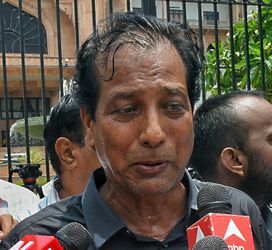The 1978 Amitabh Bachchan-starrer Don had an edge-of-the-seat stunt scene set in a Christian cemetery, where the villains try to snatch a red diary from the hero. The diary, we are told, contains the names of all the baddies inhabiting Mumbai’s underworld. The fight ends with the baddies throwing the diary into a burning car. (If they had shot in a shamshangarh, they wouldn’t have had to burn a car.) Bachchan then delivers the knockout line—that the diary that is burning is a nakli; the asli one, also red, is safe with him.
The Rajasthan assembly had an equally exciting red-diary scene last Monday. Its hero Rajendra Singh Gudha, dropped two days earlier from Ashok Gehlot’s cabinet, produced a diary of the same colour as Don Bachchan’s, and claimed it contained damning data about the crimes of his CM. The CM’s loyalists tore it from his hands, but Gudha claims to have a fairly good part of it still with him.
Gudha says he had sneaked into the house of party colleague Dharmendra Rathore in the middle of a tax raid in 2020, and had slipped out with the diary to save the CM from infamy. That is much in Bachchan style—sneaking into a building that is swarming with armed guards, and leap-frogging from floor to floor with a diary tucked into his trouser waist!
Diaries in the olden days were about chronicling history. Samuel Pepys’s diaries chronicled the plague and the Great Fire of London, as also his own sexcapades. Then there were the gripping diaries of that pristinely pure kid Anne Frank who lived in an attic in Nazi-conquered Amsterdam. In India we had Anandaranga Pillai of Puducherry, the 18th century dubashi (interpreter) who chronicled his days under Francois Dupleix.
These days, diaries are about secrets rather than chronicles. But what fogs me is why all mystery diaries are red. Gudha talks about a red diary, and flashes one in the assembly. Last month the police seized three red diaries from the Haryana home of BJP leader and actor Sonali Phogat whose death in Goa remains a crime mystery. Last September, the anti-corruption bureau found an incriminating red diary from the home of an associate of Delhi’s AAP MLA Amanatulla Khan who was being probed in a waqf board scam.
The vanished diary of Sudipto Sen, the main accused in West Bengal’s Saradha scam, was said to have been red. The diary of Italy’s mafia-hunter Paolo Borsellino that went missing after his death in a 1992 bomb attack was red. I would bet all my Swedish kronor and hawala money (if I had any of either) to claim that several of those unseen diaries that have mystified us from news reports over the last few decades were red—Bofors boss Martin Ardbo’s diaries that carried the names of his kickback payees, the Jain hawala diaries that nearly ruined the careers of a whole generation of politicians from L.K. Advani to Sharad Yadav, and more.
No one knows what is there in the Gudha diary—the snatched part or the retrieved part. That is much like Julius Caesar’s will, which the wily Mark Antony flashed before the mob, but not revealing its full content. No one knows whether that was actually Caesar’s will or something as worthless as toilet paper. The same with the Gudha diary. Show it, sir, if you have it and if it contains what you claim it does. Shut up, sir, if you don’t have it. With elections round the corner, we have better political thrillers to watch.
The million-rupee question is: why did Gudha bring the diary into the assembly? Had you or I been in his shoes, we would have kept the original in a bank locker and brought a photocopy. Right?
prasannan@theweek.in


